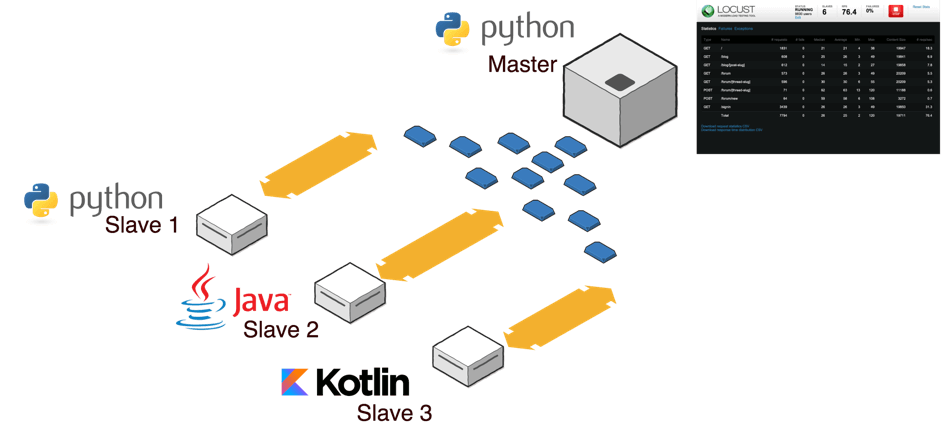Install virtualenv to current project(python 3 is required):
########### Install virtualenv
pip install virtualenv
######### Initialise the virtual environment in the current dirrectory
python3 -m venv $(pwd)/venv
###### Install all libs to the virtual environment
pip3 install -r requirements.txt
See more locust code examples in Part 1
- Write your custom tasks using
TaskSetclass:
from locust import TaskSet
class UserScenario(TaskSet):
### Standart way to define tasks
# In this task get_specific_post() method will be executed
# 2-times rarely than get_post() method
@task(1)
def get_posts(self):
self.client.get("/posts")
@task(2)
def get_specific_post(self):
self.client.get("/posts/1")
- Write tasks using predefined methods:
from locust import TaskSet
def get_posts(l):
l.client.get("/posts")
def get_post(l):
l.client.get("/posts/1")
class UserScenario(TaskSet):
### Another way to define tasks
# In this task get_post() method will be executed
# 2-times rarely than get_post() method
tasks = {get_posts: 1, get_post: 2}
- Setting up Locust Tests
class LoadTests(HttpLocust):
host = "http://example.com"
task_set = UserScenario
min_wait = 1000
max_wait = 2000
stop_timeout = 30
Let's create tasks to be executed in order according to @seq_task() priority: In this example tasks should be executed in such way as:
- get_all_posts()
- create_custom_post()
- watch_post() x 10
from locust import HttpLocust, task, events, seq_task, TaskSequence
class UserScenario(TaskSequence):
@seq_task(1)
def get_all_posts(self):
self.client.get("/posts")
@seq_task(2)
def create_custom_post(self):
self.client.post("/posts", {"title": 'foo', "body": 'bar', "userId": self.uuid})
@seq_task(3)
@task(10)
def watch_post(self):
self.client.get("/posts/1")
In this example @task decorator can be used to show the number tasks to be executed one after another. Finally tasks will be executed in such order: first will be get_all_posts() --> second is create_custom_post() task --> and the last 10 times watch_post() task
locust -f reporting_test.py --host https://jsonplaceholder.typicode.com --no-web -c 20 -r 2 -t30s --logfile=locust.log
locust --host https://jsonplaceholder.typicode.com \ # Base URL
-f locust_file.py WebsiteUser \ # file with tasks and Test instance
--no-web \ # without web console
--csv=report # will generate a report in csv format
--logfile=locust.log # will write locust tasks log to specific file
-c 20 \ # specifies the number of Locust users to spawn
-r 2 \ # specifies the hatch rate (number of users to spawn per second).
--run-time 30 \ # if you want to specify the run time for a test
--print-stats # print statistics in the console
env MAX_LATENCY=5000 locust -f scenarios/demo_scenario.py --no-web -c 500 -r 10 -t1m
env BASE_URI=http://localhost:3000 locust -f scenarios/sequence_scenarios.py LoadTests --no-web -c 100 -r 20
locust -f clients/api/api_client.py --master --master-host=localhost
locust -f clients/api/api_client.py --slave --master-host=localhost
locust -f clients/api/api_client.py --slave --master-host=localhost
locust -f scenarios/random_scenarios.py LoadTests --no-web -c 100 -r 20 -t1m
locust -f scenarios/random_scenarios.py StressTests --no-web -c 1000 -r 120
locust -f scenarios/sequence_scenarios.py LoadTests --no-web -c 100 -r 20 -t1m
locust -f scenarios/sequence_scenarios.py StressTests --no-web -c 1000 -r 120
- Init master with command:
locust -f scenarios/random_scenarios.py LoadTests \
--no-web -c 50 -r 10 \
--master \
--master-host localhost \
--expect-slaves 2 \
--run-time 30
The master will be initialized and will be waiting minimum for 2 slaves to be connected to the master
- Init slaves with commands:
locust -f scenarios/random_scenarios.py --slave --master-host=localhost
locust -f scenarios/random_scenarios.py --slave --master-host=localhost
After slaves initialization, the testing will be started.
-
Create network for locust tests:
docker network create --driver bridge locustnw -
Check network was created:
docker network inspect locustnw -
Copy files from
locust-dockerdir to the project root directory. Build Docker imagelocust-tasks:latestwith command:
docker build -t locust-tasks:latest -f Dockerfile .
- Run Docker container with locust with web client:
docker run -it --rm -p=8089:8089 \
-e "TARGET_HOST=https://jsonplaceholder.typicode.com" \
-e "ADD_OPTIONS=-c 100 -r 20" \
-e "LOCUSTFILE_PATH=scenarios/random_scenarios.py" \
-e "LOCUST_TEST=LoadTests" \
--network=locustnw savvagenchevskiy/locust-tasks:latest
OR Connect and Test the existing json-server container with json_server_performance network
docker run -it --rm -p=8089:8089 \
-e "TARGET_HOST=http://json-server:3000" \
-e "ADD_OPTIONS=--no-web -c 100 -r 20 -t30s" \
-e "LOCUST_TEST=LoadTests" \
-e "LOCUSTFILE_PATH=scenarios/sequence_scenarios.py" \
--network=json_server_performance savvagenchevskiy/locust-tasks:latest
- Run Docker container with master:
docker run --name master --hostname master -it --rm -p=8089:8089 \
-e "TARGET_HOST=https://jsonplaceholder.typicode.com" \
-e "LOCUSTFILE_PATH=scenarios/random_scenarios.py" \
-e "LOCUST_TEST=LoadTests" \
-e "LOCUST_MODE=master" \
-e "EXPECT_SLAVES=2" \
-e ADD_OPTIONS="-c 100 -r 20 --no-web" \
--network=locustnw savvagenchevskiy/locust-tasks:latest
- Run testing with spinning up 2 slaves:
docker run --name slave1 -it --rm \
--link master --env NO_PROXY=master \
-e "TARGET_HOST=https://jsonplaceholder.typicode.com" \
-e "LOCUSTFILE_PATH=scenarios/random_scenarios.py" \
-e "LOCUST_TEST=LoadTests" \
-e "LOCUST_MODE=worker" \
-e "LOCUST_MASTER=master" \
--network=locustnw savvagenchevskiy/locust-tasks:latest
docker run --name slave2 -it --rm \
--link master --env NO_PROXY=master \
-e "TARGET_HOST=https://jsonplaceholder.typicode.com" \
-e "LOCUSTFILE_PATH=scenarios/random_scenarios.py" \
-e "LOCUST_TEST=LoadTests" \
-e "LOCUST_MODE=worker" \
-e "LOCUST_MASTER=master" \
--network=locustnw savvagenchevskiy/locust-tasks:latest
Copy files from locust-docker2 dir to the project root directory
-
Building image:
docker build -t test/locust:latest -f Dockerfile . -
Running simple web:
docker run -it --rm --name locust --hostname locust \
-p=8089:8089 \
-e "ATTACKED_HOST=https://jsonplaceholder.typicode.com" \
-e "LOCUST_FILE=scenarios/random_scenarios.py" \
-e "LOCUST_OPTS=-c 100 -r 20 --no-web" \
-e "LOCUST_TEST=LoadTests" \
-v `pwd`:/locust \
test/locust:latest
- Running master with 2 slaves:
docker run -it --rm --name master --hostname master \
-p=8089:8089 \
-v `pwd`:/locust \
-e "ATTACKED_HOST=https://jsonplaceholder.typicode.com" \
-e "LOCUST_MODE=master" \
-e "LOCUST_FILE=scenarios/random_scenarios.py" \
-e "LOCUST_OPTS=-c 100 -r 20 --no-web --expect-slaves 2" \
-e "LOCUST_TEST=LoadTests" \
test/locust:latest
docker run -it --rm --name slave1 --hostname slave1 \
--link master --env NO_PROXY=master \
-v `pwd`:/locust \
-e "ATTACKED_HOST=https://jsonplaceholder.typicode.com" \
-e "LOCUST_MODE=slave" \
-e "LOCUST_MASTER=master" \
-e "LOCUST_FILE=scenarios/random_scenarios.py" \
-e "LOCUST_TEST=LoadTests" \
test/locust:latest
docker run -it --rm --name slave2 --hostname slave2 \
--link master --env NO_PROXY=master \
-v `pwd`:/locust \
-e "ATTACKED_HOST=https://jsonplaceholder.typicode.com" \
-e "LOCUST_MODE=slave" \
-e "LOCUST_MASTER=master" \
-e "LOCUST_FILE=scenarios/random_scenarios.py" \
-e "LOCUST_TEST=LoadTests" \
test/locust:latest
-
Setup kubectl configuration and connect to the cluster
-
Deploy master container
locust-masterin separatedlocustnamespace:
kubectl apply -f locust-master.yml
- Deploy slaves using command:
kubectl apply -f locust-master.yml
- Watch the Locust Web UI on the
locust-masterService:http://<load_balancer_ip>:8089
